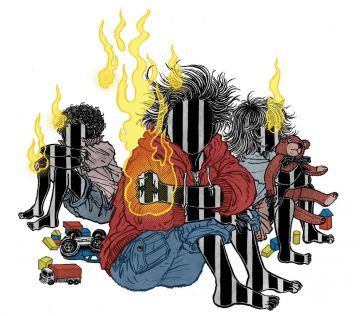Laura Miller in The New York Times:
 Stephen King’s protagonists have been hunted by all sorts of malevolent beings, from the demonic clown of “It” to the fiendish cowboy Randall Flagg in “The Stand.” But as scary as those supernatural bad guys can be, King’s most unsettling antagonists are human-size: the blocked writer sliding into delusions of grandeur and domestic violence, the fan possessed to the point of madness by someone else’s fiction, the bullied teenager made homicidal by the cruelty of her peers. We can see something of ourselves in these characters, and recognize in them our own capacity for evil. King’s latest novel, “The Institute,” belongs to this second category, and is as consummately honed and enthralling as the very best of his work. It has no ghosts, no vampires, no metamorphosing diabolical entities or invaders from other dimensions intent on tormenting innocent children. Innocent children are tormented in “The Institute,” but the people who do it are much like you and me.
Stephen King’s protagonists have been hunted by all sorts of malevolent beings, from the demonic clown of “It” to the fiendish cowboy Randall Flagg in “The Stand.” But as scary as those supernatural bad guys can be, King’s most unsettling antagonists are human-size: the blocked writer sliding into delusions of grandeur and domestic violence, the fan possessed to the point of madness by someone else’s fiction, the bullied teenager made homicidal by the cruelty of her peers. We can see something of ourselves in these characters, and recognize in them our own capacity for evil. King’s latest novel, “The Institute,” belongs to this second category, and is as consummately honed and enthralling as the very best of his work. It has no ghosts, no vampires, no metamorphosing diabolical entities or invaders from other dimensions intent on tormenting innocent children. Innocent children are tormented in “The Institute,” but the people who do it are much like you and me.
The novel opens with Tim Jamieson, an ex-cop (he was forced to resign from the Sarasota, Fla., police department after an episode he describes as a “Rube Goldberg” bungle) wandering north to South Carolina, hitchhiking and working odd jobs until he lands in DuPray, a podunk railway depot town with shuttered storefronts and a rundown motel. He takes a gig as a sort of semi-official night patrolman and finds he rather likes the place. That’s the last we’ll hear from him for quite a while, but these first 40 pages of “The Institute” — low-key and relaxed, an unaffected and genially convincing depiction of a certain uncelebrated walk of life — demonstrate how engaging King’s fiction can be even without an underlying low whine of dread.
More here.
